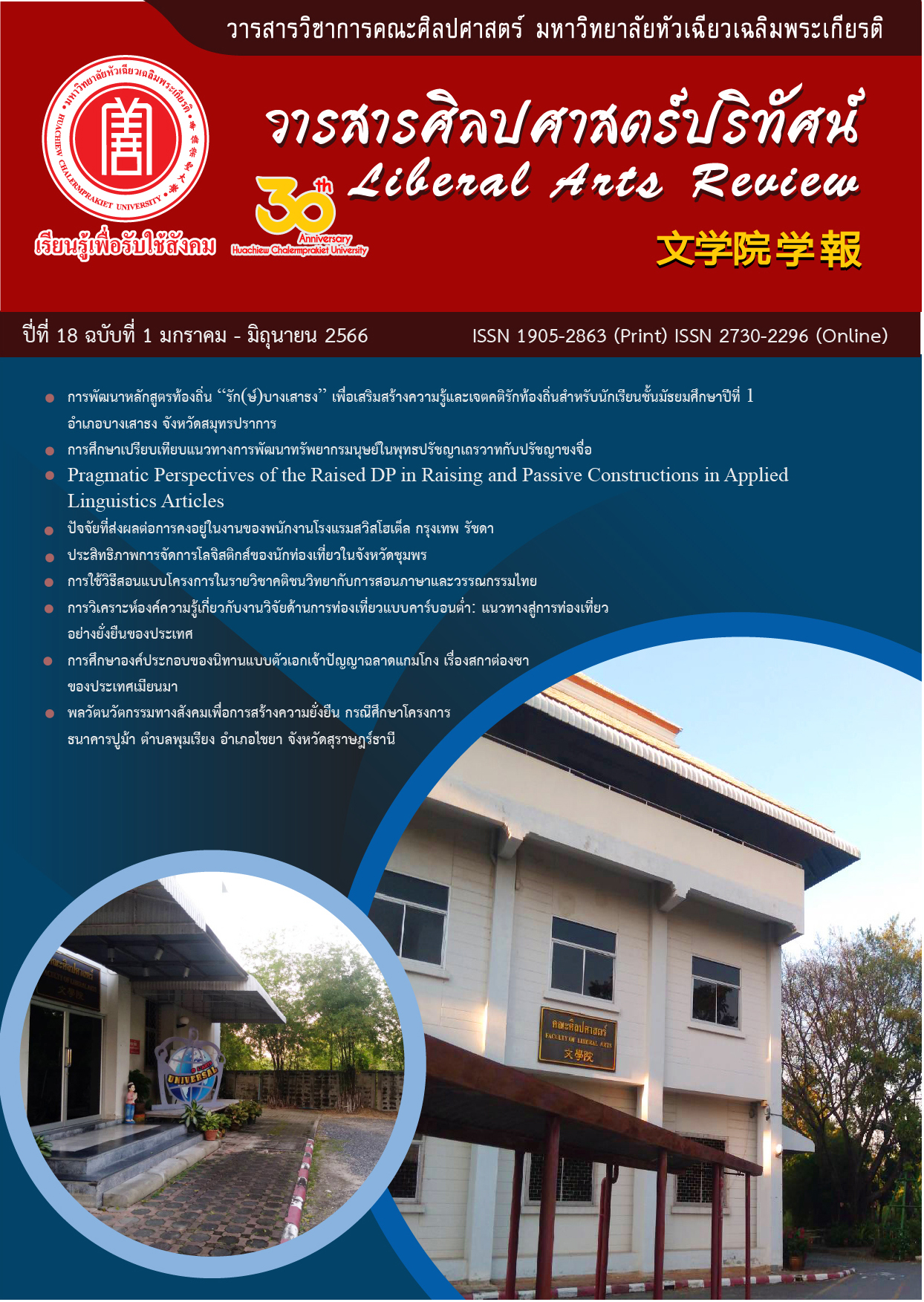Dynamics of Social Innovation to Create Sustainability Case Study: Crabs Bank in Phum Riang Subdistrict Chaiya Suratthani Province
DOI:
https://doi.org/10.14456/lar.2023.9Keywords:
Crabs bank, Social innovation, Sustainability, DynamicsAbstract
This qualitative research study explores the dynamics of social innovation for sustainability through a case study of the Crabs bank Project in Phum Riang Subdistrict, Chaiya District, Surat Thani Province. Employing methods such as area context observation and informal interviews, the study aims to examine the local community context, the challenges faced by the Blue Crab Bank Project, and the sustainable application of social innovation concepts. Currently, there are two blue swimming crab bank projects—municipal and local community-based—operating under the banner "The Truth Group releases blue swimming crabs into the Thai Sea" to address the issue of degrading coastal resources and dwindling blue crab populations. Despite facing budget constraints, the project's management has established a committee comprising community representatives who emphasize the importance of enforcing regulations, such as prohibiting the capture of small crabs, and fostering collaborative thought processes and activities centered around the local community. This approach aims to raise awareness among the community, government agencies, and private sectors involved in restoring and conserving coastal marine resources, ultimately guiding the sustainable management of the blue crab bank project.
References
กรรณิการ์ นาคฤทธิ์. (2558). การศึกษารูปแบบการจัดการทรัพยากรประมงชายฝั่งของชุมชนประมงพื้นบ้าน กรณีศึกษาธนาคารปูม้า ชุมชนคลอง อบต. หมู่ที่ 4 ตำบลบางแก้ว อำเภอบ้านแหลม จังหวัดเพชรบุรี.(สาระนิพนธ์มหาบัณฑิต). คณะสังคมสงเคราะห์ศาสตร์ มหาวิทยาลัยธรรมศาสตร์, กรุงเทพมหานคร. ค้นคืนจาก http://ethesisarchive.library.tu.ac.th/thesis/2015/TU_2015_5705036027_4917_3695.pdf.
กองยุทธศาสตร์บริหารจัดการ. (ม.ป.ป). เป้าหมายการพัฒนาที่ยั่งยืน (Sustainable Development Goals :SDGs). ค้นคืนจาก https://thailand.un.org/th/sdgs.
กาญจนา แสงลิ้มสุวรรณ. (2555). Social Innovation: More Value Than You Can Imagine. Executive Journal. 32(3), 12-15. ค้นคืนจาก https://www.bu.ac.th/knowledgecenter/executive_journal/july_sep_12/pdf/aw02.pdf
ไกรวัล ขวัญอ่อน พิราพร นุชประเสริฐ วิภาวี พิทักษ์กมลพันธ์ พรธวัล ขำงาม และพิทักษ์ ศิริวงศ์. (2559). แนวทางการสร้างความยั่งยืนของกิจกรรมธนาคารปูม้า ตำบลแหลม ผักเบี้ย อำเภอบ้านแหลม จังหวัดเพชรบุรี. วารสารวิชาการVeridian E–Journal, Silpakorn University ฉบับภาษาไทย สาขามนุษยศาสตร์ สังคมศาสตร์ และศิลปะ, 9(1), 456-469.
บรรเลง อินทร์จันทร์. (2559). นวัตกรรมสังคมอันเนื่องมาจากพระราชดำริในเขตพื้นที่ลุ่มน้ำปากพนัง จังหวัดนครศรีธรรมราช. วารสารวิจัยมหาวิทยาลัยเวสเทิร์น, 2(2), 48-56.
สำนักเลขาธิการคณะรัฐมนตรี. (2565).ประกาศเรื่องแผนพัฒนาเศรษฐกิจและสังคมแห่งชาติฉบับที่ 13 (พ.ศ. 2566-2570). ราชกิจจานุเบกษา,139(258ง), 1-149.
สำนักเลขาธิการคณะรัฐมนตรี. (2559).ประกาศเรื่องแผนพัฒนาเศรษฐกิจและสังคมแห่งชาติฉบับที่ 12 (พ.ศ. 2560-2564). ราชกิจจานุเบกษา,133(115 ก), 1-224.
พันธุ์ศักดิ์ คงเกษตร. (19 พฤศจิกายน 2565). สัมภาษณ์.
มลฤดี สนธิ และ สหรัฐ ธีระคัมพร. (2551). รายงานการศึกษารูปแบบการจัดการทรัพยากรปูทะเลอย่างยั่งยืน โดยชุมชน : กรณีศึกษาของชุมชนในเขตป่าเลนคุ้งกระเบน และป่าเลนปากน้ำเวฬุ จังหวัดจันทบุรี.กรุงเทพมหานคร:ทุนวิจัยสำนักงานคณะกรรมการวิจัยแห่งชาติ (วช.) ประจำปีงบประมาณ 2551. คณะเทคโนโลยีทางทะเล วิทยาเขตจันทบุรี. มหาวิทยาลัยบูรพา, จันทบุรี.
เรวัต ตันตยานนท์. (2559). นวัตกรรมสังคม – Social Innovation. กรุงเทพธุรกิจ. ค้นคืนจาก https://www.bangkokbiznews.com/blog/detail/637708.
สำนักงานพัฒนาวิทยาศาสตร์และเทคโนโลยีแห่งชาติ. (2543). รัตนประทีป รวมพระราชดำรัชเกี่ยวกับวิทยาศาสตร์และเทคโนโลยีในสมเด็จพระเทพรัตนราชสุดาฯ สยามบรมราชกุมารี.กรุงเทพมหานคร:ด่านสุทธาการพิมพ์, 66. ค้นคืนจาก https://waa.inter.nstda.or.th/stks/pub/2010/20100615-rattanaprateep-edit.pdf
สุธรรม กอบมณี. (19 พฤศจิกายน 2565). สัมภาษณ์.
เส้นทางเศรษฐีออนไลน์. (2563). ธนาคารปูม้า พุมเรียง โมเดลต้นแบบ ปั้นเศรษฐกิจชุมชน คืนรอยยิ้มชาวเล-ทะเลไทย. ค้นคืนจาก https://www.sentangsedtee.com/career-channel/article_158161.
อมรศักดิ์ สวัสดี, สิริวรรณ หนูเซ่ง, สมรักษ์ รอดเจริญ, วัชรี รวยรื่น, เสน่ห์ รัตนสำเนียง, ธีรพงศ์ ไกรนคร, เจริญ โต๊ะอิแต, และปิยะ แซ่เอีย. (2561). รายงานวิจัยการถ่ายทอดองค์ความรู้จากการวิจัยเพื่อการใช้ประโยชน์ในการขยายผลธนาคารปูม้าเพื่อ“คืนปูม้าสู่ทะเลไทย” ในพื้นที่ จังหวัดนครศรีธรรมราชและจังหวัดสุราษฎร์ธานี. กรุงเทพมหานคร: ทุนวิจัยสำนักงานคณะกรรมการวิจัยแห่งชาติ (วช.) ประจำปีงบประมาณ 2561. สำนักวิชาวิทยาศาสตร์.มหาวิทยาลัยวลัยลักษณ์. ค้นคืนจาก https://inter.fisheries.go.th/eng/en_pic/202103041528541_file.pdf
Butzin, A., Howaldt, J., Weber, M. & Schaper-Rinkel, P. (2014). Theoretical approaches to social innovation. A critical literature review, 79-96. Retrieved from https://www.iat.eu/aktuell/veroeff/2014/literature-review.pdf
Caulier-Grice, J. (2010). Social innovation exchange. Retrieved from http://socialinnovator.info/blog/ social-innovator/what-social-innovation.
Charles A.T. (2000). Sustainable Fishery Systems. New York: Blackwell Science.
Damanpour, F. (1991). Organizational innovation: A meta analysis effects of determinants & moderators. Academy of Management Journal, 34, 555-590.
Drazin, Robert, Mary Ann Glynn, & Robert K. Kazanjian. (1999). “Multilevel theorizing about creativity in organizations: A sense making perspective.” Academy of Management Review 24(2), 286-307.
Edgington, N. (2010). Austin entrepreneur network. Retrieved from http://austinentrepreneurnetwork.org/2010/ 01/what-is-socialinnovation/
FAO. (2012). Total production 1950-2010. Retrieved from https://www.fao.org/fishery/statistics-query/en/global_production.
Gryskiewicz, S. Epstein, R. (2000). Cashing in on creativity at work. Psychology Today, 33(5), 62-66.
Mulgan, G., Tucker, S., Ali, R., & Sanders, B. (2007). Social Innovation: What Is It, why It matters and How it can be accelerated. Retrieved from https://www.youngfoundation.org/our-work/ publications/social-innovation-what-it-is-why-it-matters-how-it-can-be-accelerated/
Nitiratsuwan, T. & Juntarashote, K . (2004). Sustainable management measures for blue Swimming crab (Portunus pelagicus) fishery: A case study in Sikao district, Trang province, Thailand. In Proceedings of the 12th Biennial Conference of the International Institute of Fisheries Economics & Trade (IIFET). Tokyo, Japan: Tokyo University of Marine Science & Technology. Retrieved from file://C:/Users/Acer/Downloads/337.pdf
Downloads
Published
How to Cite
Issue
Section
License
Copyright (c) 2023 Liberal Arts Review

This work is licensed under a Creative Commons Attribution-NonCommercial-NoDerivatives 4.0 International License.
บทความที่ได้รับการตีพิมพ์เป็นลิขสิทธิ์ของวารสารศิลปศาสตร์วิชาการและวิจัย
ข้อความที่ปรากฏในบทความแต่ละเรื่องในวารสารวิชาการเล่มนี้เป็นความคิดเห็นส่วนตัวของผู้เขียนแต่ละท่านไม่เกี่ยวข้องกับมหาวิทยาลัยหัวเฉียวเฉลิมพระเกียรติ และคณาจารย์ท่านอื่นๆ ในมหาวิทยาลัยฯ แต่อย่างใด ความรับผิดชอบองค์ประกอบทั้งหมดของบทความแต่ละเรื่องเป็นของผู้เขียนแต่ละท่าน หากมีความผิดพลาดใดๆ ผู้เขียนแต่ละท่านจะรับผิดชอบบทความของตนเองแต่ผู้เดียว




